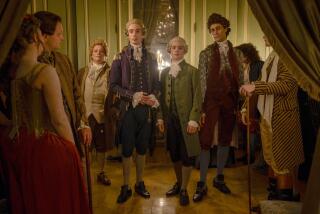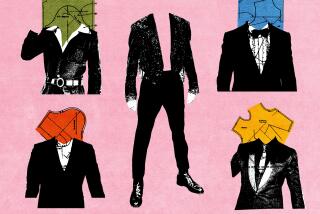Fashion 88 : Black-Tie: A Priority for Propriety
- Share via
Until the Duke of Windsor chafed at the neck 70 years ago, gentlemen wore starched wing collars with their dinner clothes. But the style-setting duke, who dined in black-tie every night, banished wings for flat collar styles--and society on two continents followed suit.
Things change.
Suddenly, starchy, stand-up wing collars are on the rise. They’re on 60% of all evening shirts sold and on 85% of all evening shirts rented--just one of many indicators that formality for men is back in style.
Sales of tuxedoes are booming too. They’ve risen 30% in the past three years at After Six Formals, the country’s largest manufacturer of men’s formal wear, creative director Peter Dunn says.
And at Lord West, the country’s second largest tuxedo producer, president Harvey Weinstein says sales have climbed 5% each year for the past eight years.
More men are donning black-tie for concerts, theaters, home and restaurant parties than at any time since the 1930s, trend-watchers agree. In fact, formal wear is in such a boom that some predict black-tie may soon not be formal enough.
Says designer John Weitz, tongue only partly in cheek: “If this continues, we’ll see a return to (the even more formal) white tie, starched shirt and tails. There’s a regressive, 1930s thinking in the air, with lots of people wishing they were counts or dukes.”
But economy and a yen for traditional elegance are the real reasons for the tuxedo surge, Weitz and most menswear insiders agree. A conservatively styled, off-the-rack tuxedo ($495 at Brooks Bros., from $400 to $1,000 at department and specialty stores), seems a sound investment for baby boomers entering into lives of social responsibility.
“Young men who know little about clothes and even less about personal style have discovered they can wear tuxedoes and instantly look great,” says Timothy Hawkins, a fashion editor at Daily News Record, the bible of the menswear world.
“Anyone involved in the social or charity scene on either coast simply has to own a tuxedo these days,” he adds.
The operative word is own, rather than rent.
“Proportion is everything,” Hawkins says. “The secret is to shop at a place where they know how to fit you, to make you look elegant and feel comfortable. Then you can forget about everything else. With that suit in your closet you are secure; you go to any black-tie event and look right. And unless you gain weight, you can wear it for years.”
Author-designer Alan Flusser agrees. In his book “Clothes and the Man,” Flusser anatomizes formal wear for those who weren’t to the manner born.
”. . . No other form of dress is as steeped in such a ritualistic sense of propriety. . . .” he writes. “There is something so elegant about the simplicity of black and white, with its stark contrast and lack of pattern, that when the elements are properly put together, they present man at his most debonair.”
There are only four proper tuxedo styles to choose from, he believes: peaked lapel or shawl lapel, in single- or double-breasted styles.
Notched lapels are forbidden in Flusser’s world, because he says they “look commercial” and downgrade the tuxedo wearer’s elegance. But Flusser is more of a purist than most.
Notched lapels, styled the same as lapels on daytime suits, are on 60% of all tuxedoes sold these days, even at the finer stores. It’s part of the natural-shoulder, Ivy League look that President-elect George Bush often wears.
Ben Ditto, owner of Houston’s Norton Ditto menswear shop and “a good friend of George Bush’s for many years,” reports that Bush “just buys his clothes out of stock.”
Bush’s $600, off-the-rack, Southwick brand tuxedo (Size 42 long), has grosgrain notch lapels, natural shoulders and no suppression at the waist, Ditto says. He wears it with a black cummerbund and a pleat-front shirt.
“The only people who wear shaped tuxedos are those who go to rental parlors,” Ditto says. “In our shop, you never find slanted pockets or jackets with double vents. We’re conservative.”
Ditto himself wears the peak-lapel, single-breasted model, which has a bit of shoulder padding. And even purists like Flusser say this is the most versatile choice for men who own only one tuxedo style.
“The peak lapel is the direct descendant of the original tail coat, which spawned the tuxedo in the late 1800s when King Edward VII simply ordered the tails of his formal wear removed,” the author explains.
Flusser, who designed clothes for the film “Wall Street,” believes there are certain unbreakable formal-wear rules: “Tuxedo jackets must never have flap pockets. Pockets without flaps are the dressiest.”
Jackets should have double vents or no vents. A single back vent is “the least functional and least elegant” style. (But 99% of off-the-rack tuxedos have single back vents, he concedes.)
Pants should be double pleated, must never have cuffs and should break just at the top of the shoe. The side of each trouser leg should be detailed with satin braid.
Shirts must have French cuffs and should extend one-half to three-quarters of an inch below the jacket sleeve. Shirt collars may be stand-up wings or the more comfortable turn-down styles, with soft-pleated fronts.
Trouser waistbands must never be exposed. They are covered by a cummerbund or vest. The cummerbund pleats should always point upward. (This was where men placed their theater tickets in the good old days.)
The caveats continue, although Flusser knows he is speaking the equivalent of Greek to many American men, who still don’t know what differentiates a tuxedo jacket from a dinner jacket from black-tie attire. The answer is nothing, experts agree.
A dinner jacket, dinner suit, tuxedo and black-tie attire are all synonymous terms. In fact the very word tuxedo is considered tacky in certain social sets.
It originated in the 1880s, historians say, when a dandy named Griswold Lorillard wore a tailless dinner jacket to a white-tie ball in Tuxedo Park, New York. Until then, tails had been compulsory for formal wear. But Lorillard’s look appealed to the blue bloods, who wore it from then on. Americans called it a tuxedo, after the name of the town in which it was born. But the word is relatively unknown in other countries, and worldly types refer to their dinner jackets, dinner coats or dinner suits rather than say tuxedo .
Weitz, for example, speaking from Palm Beach, Fla., the other day, explained that he was on his way out to dine. What are you wearing? he was asked. “I’m in my black dinner suit, white shirt, black bow tie,” he replied.
In other words, he had on his tuxedo.
More to Read
Sign up for Essential California
The most important California stories and recommendations in your inbox every morning.
You may occasionally receive promotional content from the Los Angeles Times.













